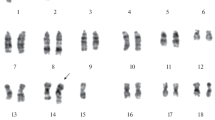Abstract
The induction of apoptosis by anticancer drugs and its relationship to stages of the cell cycle was studied in cells derived from a solid tumour; a highly malignant hamster fibrosarcoma (Met B). Asynchronously proliferating cells were treated with a wide variety of agents such as actinomycin-D, 1-β-D-arabinofuranosyl cytosine, camptothecin, cisplatin, cyclophosphamide, daunorubicin, 5-flurouracil, 6-mercaptopurine, hydroxyurea, ionomycin, methotrexate and vincristine. With the exception of cyclophosphamide and hydroxyurea, a 36 h exposure to these drugs resulted in inhibition of cell growth and apart from cyclophosphamide, hydroxyurea, 6-mercaptopurine and cisplatin the induction of apoptosis. Studies using a decreased concentration of drug and exp osure time (12 h) followed by examination of cells using flow cytometry indicated that most drugs were capable of affecting cell cycle progression without induction of apoptosis. However when cells were synchronised at G0/G1, S and G2/M phases and then exposed to these decreased concentrations of drug apart from 6MP an HU, apoptosis was observed and for the majority of drugs it took place in the same phase in which progression through the cell cycle was blocked by the drug. Cells synchronised in G0/G1 phase were more susceptible to methotrexate, whereas S-phase cells were more susceptible to camptothecin and 5-flurouracil and G2/M phase cells more susceptible to actinomycin D, 1-β-D-arabinofuranosyl cytosine, daunorubicin and cisplatin. In contrast, vincristine blocked cells in G2/M phase but exerted its apoptotic effect in S-phase cells, ionomycin had no effect on the cell cycle, but G2/M cells appeared to be more susceptible to the effect of this drug. These data indicate that entry into apoptosis by this fibrosarcoma may occur at any point in the cell cycle. They also demonstrate a correlation between the action of some anticancer drugs on the cell cycle and the subsequent induction of apoptosis which may be useful in chemotherapeutic design.
Similar content being viewed by others
References
Dive C, Hickmann JA: Drug target interactions: only the first step in the commitment to a programmed cell death. Br J Cancer 64: 192–196, 1991
Hickman JA: Apoptosis induced by anticancer drugs. Cancer Metastasis Rev 11: 121–139, 1992
Hill BT: The cell cycle and its significance for cancer treatment. Cancer Treat Rev 2: 159–175, 1975
Kerr JF, Wyllie AH, Currie AR: Apoptosis: a basic biological phenomenon with wide ranging implications in tissue kinetics. Brit J Cancer 26: 239–257, 1972
Wyllie AH, Kerr JFR, Currie AR: Cell death: the significance of apoptosis. Int Rev Cytol 68: 251–306, 1980
Gorczyca W, Gong J, Ardelt B, Traganos F, Darzynkiewicz Z: The cell cycle related differences in susceptibility of HL-60 cells to apoptosis induced by various antitumour agents. Cancer Res 53: 3186–3192, 1993
Cotter TG, Glynn JM, Echeverri F, Green DR: The induction of apoptosis by chemotherapeutic agents occurs in all phases of the cell cycle. Anticancer Res 12: 773–780, 1992
El Alaoui S, Mian S, Lawry J, Quash G, Griffin M: Cell cycle kinetics, tissue transglutaminase and programmed cell death (apoptosis). FEBS Lett 2: 174–178, 1992
Pratt NR, Lowther GW, Rees RC, Teale DM, Potter CW: Non random chromosome changes in a herpes-virus-transformed syrian hamster cell line and its metastatic derivatives. Int J Cancer 34: 849–853, 1984
Sen S, D'Incaki M: Apoptosis: Biochemical events and relevance to cancer chemotherapy. FEBS Lett 307: 122–127, 1992
Darzynkiewicz Z, Kapuscinski J: Acridine orange: a versatile probe of nucleic acids and other cell constituents. In: Melamed MR, Lindmo T, Mendelson L (eds) Flow Cytometry and Sorting, Second Edition, Wiley & Sons, Inc., New York 291–314, 1990
Kuzmich S, Tew KD: Detoxification mechanisms and tumor cell resistance to anticancer drugs. Medicinal Research Reviews 2: 185–217. J Wiley & Sons, New York, 1991
Pardee AB: G1 events and regulation of cell proliferation. Science 246: 603–608, 1989
Lennon SV, Martin SJ, Cotter TG: Dose dependent induction of apoptosis in human tumor cell lines by widely diverging stimuli. Cell Prolif 24: 203–214, 1991
Barry MA, Behnke CA, Estman A: Activation of programmed cell death (apoptosis) by cis platin, other anticancer drugs, toxins and hyperthermia. Biochem Pharmacol 40: 2353–2362, 1990
Del Bino G, Skierski JS, Darzynkiewisz Z: Diverse effect of camptothecin, an inhibitor of topoisomerase I, on the cell cycle of lymphocytic (L1210, Molt4) and myelogenous (HL-60, KG1) leukemic cells. Cancer Res 50: 5746–5750, 1990
Horwitz SB, Horwitz MS: Effect of camptothecin on the breakage and repair of DNA during cell cycle. Cancer Res 33: 2834–2836, 1973
Martin SJ, Cotter TG: Disruption of microtubules induces an endogenous suicide pathway in human leukemia HL-60 cells. Cell and Tissue Kinetics 23: 545–559, 1990
Johnson TS, Knight CRL, El-Alaoui S, Mian S, Rees RC, Gentile V, Davies PJA, Griffin M: Transfection of tissue transglutaminase into a highly malignant hamster fibrosarcoma leads to a reduced incidence of primary tumour growth. Oncogene 9: 2935–2942, 1994
Fairchild CR, Maybaum J, Straw J: Enhanced cytotoxicity with methotrexate in conjunction with hypoxanthine in L1210 cells in culture. Cancer Chemother Pharmacol 22: 26–32, 1988
Liu LF: DNA topoisomerase poisons as antitumour drugs. Ann Rev Biochem 58: 351–375, 1989
Solary E, Bertrand R, Kohn KW, Pommier Y: Differential induction of apoptosis in undifferentiated and differentiated HL-60 cells by DNA topoisomerase I and II inhibitors. Blood 5: 1359–1368, 1993
Holm C, Covey JM, Kerrigan D, Pommier Y: Differential requirement of DNA replication for the cytotoxicity of DNA topoisomerase I and II inhibitors in Chinese hamster DC3F cells. Cancer Res 50: 6365–6368, 1989
Kaufmann SH: Antagonism between camptothecin and topoisomerase II-directed chemotherapeutic agents in a human leukemia cell line. Cancer Res 51: 1129–1136, 1991
Hickman JA, Beere HM, Wood AC, Waters CM, Parmar R: Mechanisms of cytotoxicity caused by antitumor drugs. Pharmacol Lett 64/65: 553–561, 1990
Author information
Authors and Affiliations
Rights and permissions
About this article
Cite this article
Alaoui, S.E., Lawry, J. & Griffin, M. The cell cycle and induction of apoptosis in a hamster fibrosarcoma cell line treated with anti-cancer drugs: Its importance to solid tumour chemotherapy*. J Neurooncol 31, 195–207 (1997). https://doi.org/10.1023/A:1005782708570
Issue Date:
DOI: https://doi.org/10.1023/A:1005782708570



